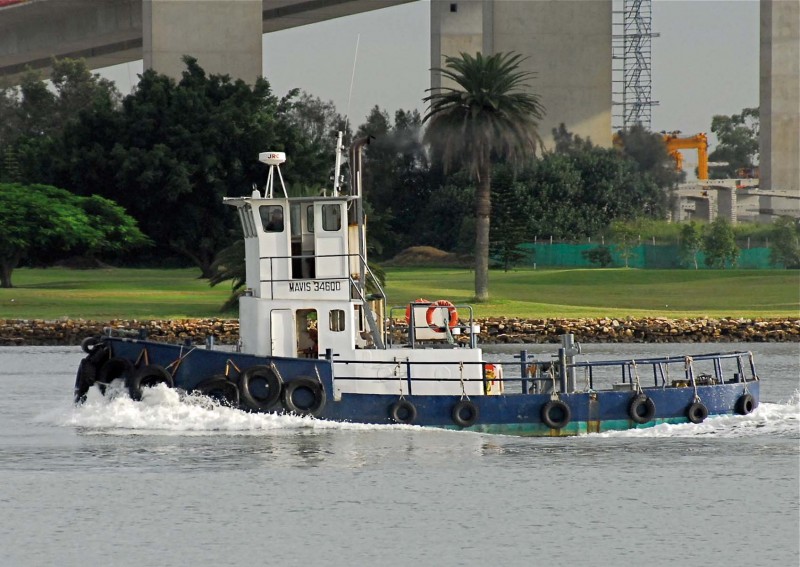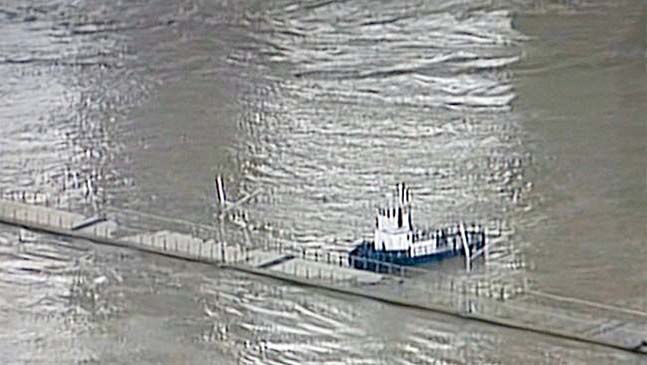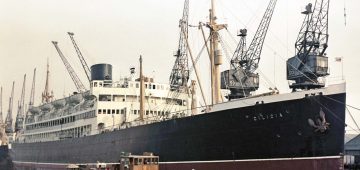The Heroic Tugboat Mavis
by Robert Wyatt

Tugs, the largely unsung servants of the worlds waterways, now have another achievement to add to their vast collection.
Queensland Australia in 2010, after being in drought for nearly seven years, received its heaviest and almost continuous rainfall since 1974. Vast inland areas of this State were in flood. Many towns were cut off, and some had to be evacuated by helicopters.
On Christmas Day 2010, the area was receiving even more of the torrential rain, particularly in the South East Corner of Queensland, its most populated region. Toowoomba, a town to the west of the Capital Brisbane, was the first to be flooded. This caused the loss of several lives in the main street. Next was the nearby Lockyer Valley, and its small dormitory communities, unfortunately with more loss of life.
Brisbane, Australia’s third largest city, was right in the path of this vast amount of water. The Dams built to help protect the City after the disastrous floods of 1974, were at danger levels, causing water to be released into the already swollen Brisbane River. This river’s tributaries also added to the looming calamity.
On January 11th 2011, Brisbane started ‘to go under’. An outer Western Suburb was first. Then it was a domino effect, as riverside suburb after suburb followed, including the City’s business heart. In all 29,000 homes and businesses were flooded. Many homes not flooded, were without power, fresh food, clean water, or sewerage.
Ipswich, the first suburb to be flooded, lost its shopping Mall and supermarkets, and was isolated for a week.
As the flooded river gathered strength, it began to destroy much of the local infrastructure, such as wharves, ferry terminals, marinas, a floating restaurant, and also the large floating Riverwalk, that was such a feature in the City of Brisbane C.B.D. The River City was now a City in a River.
This floating walkway, although initially attached to the shore, started to break into sections as the flood level rose by the hour. At the flood peak this walkway broke adrift, and was at the mercy of the river. It headed downstream at a Police recorded speed of 21 knots. It carried all before it like a runaway tank, its erratic behaviour dictated by the direction of the current. Further down river was the Gateway Bridge. A major river crossing for the City. The Bridge pylons with the surging water flowing either side, stood in the path of the drifting menace.
A police launch, following several large sections of the walkway, was powerless to exert any control over them, and could only watch in shocked disbelief, as one large section headed straight for the bridge structure.

To those watching from the banks of the brown swirling river, a grave disaster was unfolding before their eyes. The police on duty on the Bridge had closed all its lanes in preparation for the collision that seemed imminent, possibly putting the bridge out of service for years.
The owner of a local company, Bowen Tugs and Barges had been listening to his radio aboard one of his tugs, Mavis, when on his own initiative he set off up river to look for the drifting wreckage hopefully to be of some assistance.
Just above the Gateway Bridge and through a break in the rain. He was lucky enough to catch sight of the largest section of the walkway. The current had pushed it diagonally across the river, and in a perfect position to hit the left hand roadway support.

Moving quickly into position alongside this section of walkway, while fighting the current at the same time, he used the tug’s bows to nudge the wreckage into such a position that it would float completely under the bridge, without it hitting any part of the structure, realising at the time his tug was in extreme danger of being rolled over by the weight of water coming down the river or being crushed against one of the pylons by the walkway. Once clear of the bridge, the tug master kept the tug near to the wreckage, nudging it as necessary, so it would not hit nearby wharves, a marina or several refuelling jetties on its wild journey.
Following the wrecked section out into Moreton Bay and now clear of any further danger, the Master pushed the entire structure on to a local beach making sure it was anchored so it would not cause any further problems. It could remain there until it would be demolished or recycled.
When interviewed later the Tug Masters only comment was “All in a days work”.
The story of the tug Mavis didn’t end there. For the next five weeks her owners continued to patrol the flooded river collecting and then disposing of any debris that could or would endanger shipping in the port of Brisbane, and any of the river’s infrastructure. When the flooded river had returned to its usual characteristics the owners returned the tug to her normal duties towing barges around the port.
The owners of the tug, Doug Hislop and Peter Fenton, were both nominated in the heroism category of the Queensland section of the Pride of Australia awards. In addition to that award they were both to be given the State Premier’s medal for bravery.
Unfortunately, only one of the two owners, Doug Hislop was able to accept the awards in person. Peter Fenton’s awards were posthumous. Two days before the awards ceremony, Peter Fenton was killed in a tragic accident at the Port of Brisbane when he was hit by a large steel crate that fell from a sling of a ships crane. Peter was on a barge delivering stores to the tanker British Beech berthed at the oil jetty.
It is an ending to my story I would not have envisaged.



Comments
Sorry, comments are closed for this item